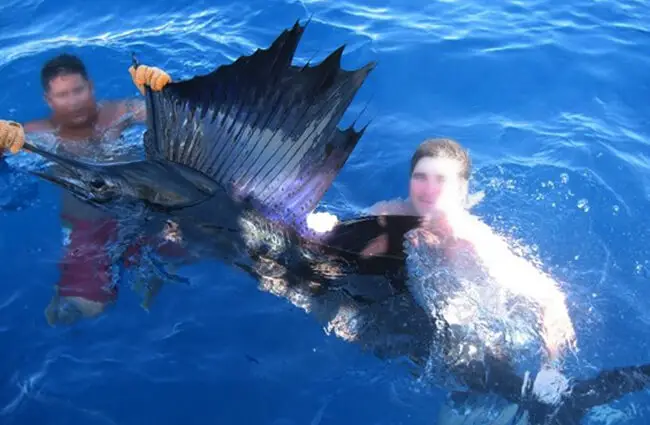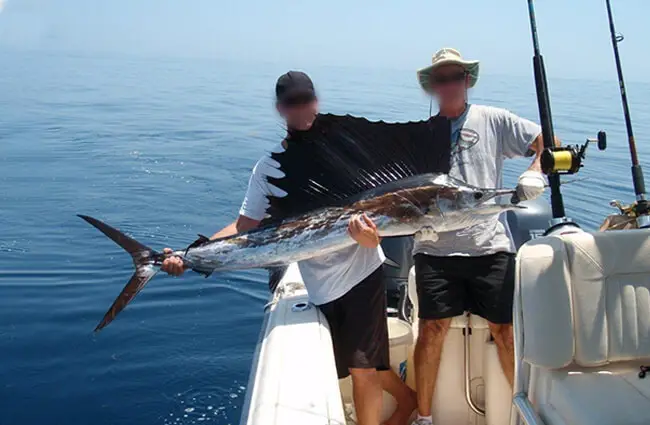In the vast, shimmering expanse of the ocean, a creature of unparalleled speed and striking beauty reigns supreme: the Sailfish. Often hailed as the fastest fish in the sea, this magnificent billfish is far more than just a blur beneath the waves. It is a finely tuned predator, a vital component of marine ecosystems, and a source of endless fascination for scientists and enthusiasts alike. Join us on a deep dive into the world of the Sailfish, exploring its incredible biology, its role in the ocean, and its intriguing interactions with humanity.
The Ocean’s Sprinter: An Introduction to the Sailfish
The Sailfish, belonging to the genus Istiophorus, is instantly recognizable by its towering, sail-like dorsal fin and its elongated, spear-like bill. These features are not mere ornamentation; they are crucial tools for survival in the open ocean. There are two recognized species: the Atlantic Sailfish (Istiophorus albicans) and the Indo-Pacific Sailfish (Istiophorus platypterus), both sharing the same remarkable characteristics that make them apex predators.
Imagine a fish capable of bursts of speed exceeding 68 miles per hour (110 kilometers per hour). This incredible velocity allows the Sailfish to chase down agile prey and escape potential threats with breathtaking efficiency. Its sleek, hydrodynamic body, combined with its powerful tail, makes it a true marvel of natural engineering.
![Sailfish hunting sardinesPhoto by: Rodrigo Friscione / NOAA's National Ocean Service [public domain]https://creativecommons.org/licenses/by/2.0/](https://animals.net/wp-content/uploads/2020/02/Sailfish-2-650x425.jpg)
Where the Sailfish Calls Home: Habitat and Distribution
Sailfish are creatures of the open ocean, preferring the warm, tropical and subtropical waters of the Atlantic, Pacific, and Indian Oceans. They are pelagic, meaning they live in the open sea, away from the coast and the seabed. These magnificent fish are highly migratory, following warm currents and schools of baitfish across vast distances.
- Atlantic Sailfish: Found throughout the tropical and subtropical Atlantic Ocean, including the Caribbean Sea, Gulf of Mexico, and along the eastern coasts of North and South America, as well as the western coast of Africa.
- Indo-Pacific Sailfish: Inhabits the tropical and subtropical regions of the Indian and Pacific Oceans, ranging from the Red Sea and East Africa across to Southeast Asia, Australia, and the western Americas.
They typically inhabit surface waters down to depths of around 650 feet (200 meters), often found near the thermocline, where temperature changes create rich feeding grounds. Their presence is a strong indicator of a healthy marine ecosystem.
A Hunter’s Diet: What Fuels the Fastest Fish?
As apex predators, Sailfish have a diet consisting primarily of smaller schooling fish and cephalopods. Their menu includes a variety of species, reflecting the abundance of prey in their diverse habitats.
- Primary Prey: Sardines, anchovies, mackerel, herring, ballyhoo, and other small schooling fish.
- Secondary Prey: Squid and octopuses.
Their hunting strategy is as impressive as their speed, often involving cooperative efforts to herd prey. More on this fascinating behavior later.
Fascinating Facts About Sailfish
Here are some quick, intriguing insights into the world of the Sailfish:
- Record Breaker: Widely considered the fastest fish in the ocean, capable of reaching speeds up to 68 mph (110 km/h).
- The Sail’s Purpose: The large dorsal fin, or “sail,” is believed to be used for thermoregulation, display, and herding prey.
- Color Changing: Sailfish can rapidly change their body coloration, often displaying vibrant blue and silver hues, especially during hunting or excitement.
- Longevity: They typically live for about 4 to 5 years, though some individuals may reach up to 10 years.
- Size Matters: Can grow up to 11 feet (3.4 meters) in length and weigh over 220 pounds (100 kilograms).

Diving Deeper: The Biology and Ecology of Sailfish
For those eager to understand the Sailfish beyond its surface appeal, a closer look at its biology reveals a creature perfectly adapted to its oceanic existence.
Physical Characteristics and Adaptations
The Sailfish’s anatomy is a masterclass in evolutionary design for speed and predation.
- The Sail (Dorsal Fin): This prominent feature can be as tall as the fish’s body is deep. It is typically kept folded down while swimming at high speeds, but can be rapidly erected.
- Thermoregulation: The sail is highly vascularized, meaning it has many blood vessels. Erecting it at the surface may help the fish warm up or cool down by exposing blood to the air or water.
- Display: It is used for communication, particularly during hunting or mating rituals, making the fish appear larger and more intimidating.
- Herding: When hunting, the erected sail may help create a visual barrier, aiding in corralling schools of fish.
- The Bill (Rostrum): A long, pointed upper jaw, not as rounded as a Marlin’s bill. It is used to slash and stun prey, making them easier to catch.
- Body Shape: A streamlined, fusiform body reduces drag, allowing for incredible acceleration and sustained speed.
- Coloration: Typically dark blue to gray on the dorsal side, fading to silvery white on the belly. Vertical stripes often appear on the flanks, especially when excited or hunting, providing camouflage against the backdrop of the open ocean.
- Fins: In addition to the large dorsal sail, they possess strong pectoral fins, a small second dorsal fin, and a deeply forked caudal (tail) fin, which provides immense propulsion.
Habitat and Distribution: A Global Wanderer
Sailfish are truly cosmopolitan, inhabiting vast stretches of the world’s oceans. Their preferred environment is characterized by:
- Temperature: Warm waters, generally above 70°F (21°C).
- Salinity: Open ocean salinity levels.
- Depth: Primarily epipelagic (surface waters) and mesopelagic (twilight zone) zones, typically from the surface down to 650 feet (200 meters).
- Migration: They undertake extensive migrations, often following warm ocean currents and the seasonal movements of their prey. For example, Atlantic Sailfish migrate along the eastern coast of Florida during winter months, creating famous sport fishing opportunities.
Diet and Hunting Strategies: The Art of the Slash
The Sailfish’s hunting prowess is a spectacle of coordination and precision.
- Cooperative Hunting: Sailfish often hunt in groups, working together to herd schools of smaller fish into tight “bait balls.” This makes it easier for individual fish to attack.
- The Slash and Grab: Once a bait ball is formed, individual Sailfish will dart into the school, using their bills to slash and stun prey. They do not spear the fish; rather, they deliver rapid, sideways blows. Studies have shown they are incredibly accurate, often targeting a single fish with each slash.
- Feeding: After stunning their prey, they quickly turn to consume the incapacitated fish. This method minimizes energy expenditure compared to chasing individual fish at high speed.

Reproduction and Life Cycle: A Legacy in the Waves
The life cycle of a Sailfish begins with a remarkable act of oceanic reproduction.
- Spawning: Sailfish are pelagic spawners, releasing vast numbers of eggs and sperm directly into the water column. Spawning typically occurs in warm, tropical waters throughout the year, with peaks during certain seasons.
- Fecundity: A single female can release millions of eggs in one spawning event, a strategy to compensate for high mortality rates among eggs and larvae.
- Larval Stage: The eggs hatch into tiny larvae that bear little resemblance to adult Sailfish. These larvae drift with ocean currents, feeding on zooplankton. They are highly vulnerable to predation.
- Growth: Growth is rapid. Within their first year, Sailfish can reach lengths of 4 to 5 feet (1.2 to 1.5 meters). They reach sexual maturity relatively quickly, often by 2 to 3 years of age.
- Lifespan: While some can live up to 10 years, the average lifespan is shorter, around 4 to 5 years, due to predation and fishing pressure.
Evolutionary History: Tracing the Lineage
Sailfish belong to the family Istiophoridae, which also includes marlins and spearfishes. This group of billfishes evolved from a common ancestor millions of years ago, adapting to life as fast-swimming, open-ocean predators. Fossil records indicate that billfishes have been present in the oceans for at least 60 million years, with some of the earliest forms appearing in the Paleocene epoch. Their distinctive bills and streamlined bodies are prime examples of convergent evolution, where similar traits evolve independently in different species due to similar environmental pressures.
Sailfish in the Ecosystem: A Crucial Link
Beyond their individual prowess, Sailfish play a significant role in maintaining the health and balance of marine ecosystems.
Contribution to the Ecosystem
As apex predators, Sailfish help regulate the populations of smaller schooling fish. By preying on these species, they prevent overpopulation and ensure the health of the prey fish stocks. This top-down control is essential for maintaining biodiversity and the overall stability of the food web. Their presence indicates a robust and productive marine environment.
Interaction with Other Animals
- Predator-Prey Dynamics: Sailfish are predators to a wide array of smaller fish and cephalopods. In turn, juvenile Sailfish can fall prey to larger pelagic predators like sharks and other billfish. Adult Sailfish have few natural predators due to their size and speed, though large sharks and killer whales might occasionally target them.
- Cooperative Hunting: Their unique cooperative hunting behavior with other Sailfish is a prime example of complex social interaction in marine life.
- Symbiotic Relationships: While not strictly symbiotic, Sailfish are often observed alongside other large pelagic species, such as tuna, in areas of high prey concentration.

Sailfish and Humanity: Interaction and Conservation
The Sailfish’s beauty and power have long captivated humans, leading to a complex relationship that spans sport, commerce, and conservation.
Conservation Status and Threats
While not currently listed as endangered, Sailfish populations face several threats:
- Overfishing: Both commercial and recreational fishing exert pressure on Sailfish populations. Although often released in sport fishing, post-release mortality can occur. Commercial fisheries, particularly longline operations, can catch Sailfish as bycatch.
- Habitat Degradation: While open ocean dwellers, their prey species are often impacted by coastal pollution and habitat destruction, which can indirectly affect Sailfish.
- Climate Change: Changes in ocean temperature and currents can alter prey distribution and migration patterns, potentially impacting Sailfish feeding and spawning grounds.
Conservation efforts focus on sustainable fishing practices, catch-and-release programs, and international cooperation to manage highly migratory species.
Human Interaction and Cultural Significance
- Sport Fishing: Sailfish are highly prized by recreational anglers for their acrobatic leaps and powerful fights. They are a cornerstone of the sport fishing industry in many tropical regions, particularly Florida, Mexico, Costa Rica, and parts of the Indo-Pacific. The emphasis is often on catch-and-release to promote conservation.
- Commercial Fishing: While not typically a primary target for large-scale commercial fisheries, Sailfish are caught as bycatch in tuna and swordfish longline operations. Their meat is consumed in some regions.
- Tourism: Sailfish attract eco-tourists and divers, especially those seeking to witness their incredible hunting displays. This provides economic incentives for local communities to protect their marine environments.
- Cultural Symbolism: Their speed, beauty, and power have made them symbols of strength and grace in many coastal cultures, often appearing in art and folklore.
Finding Sailfish in the Wild: A Guide for Animal Lovers
For those hoping to witness a Sailfish in its natural habitat, patience and preparation are key:
- Location: Focus on known Sailfish hotspots during their peak seasons.
- Atlantic: The waters off Florida (especially during winter), Costa Rica, Mexico (Yucatan Peninsula), and parts of the Caribbean.
- Indo-Pacific: Australia (Great Barrier Reef), Indonesia, the Philippines, and parts of East Africa.
- Timing: Research peak migration and feeding seasons for your chosen location. These often coincide with cooler water temperatures that concentrate baitfish.
- Methods:
- Charter Fishing: The most common way to encounter Sailfish. Reputable charters often practice catch-and-release.
- Diving/Snorkeling: While less common to encounter them up close due to their speed, opportunities arise, especially during bait ball events. Look for tours specializing in “bait ball” encounters.
- Observation from Boats: Keep an eye out for diving birds, which often indicate baitfish schools, and potentially Sailfish feeding below.
- Respectful Observation: Always maintain a safe distance and never attempt to approach or touch a wild Sailfish.
Encountering a Sailfish in the Wild: What to Do
If you are swimming, diving, or boating and encounter a Sailfish:
- Maintain Distance: Sailfish are powerful predators with a sharp bill. While not inherently aggressive towards humans, they can cause serious injury if they feel threatened or are disoriented. Keep a respectful distance, at least 10-15 feet (3-5 meters).
- Observe Calmly: Enjoy the rare spectacle. Do not make sudden movements or attempt to chase or touch the fish.
- Do Not Feed: Never attempt to feed a wild Sailfish. This can alter their natural behavior and make them associate humans with food, leading to dangerous encounters.
- If Fishing: If you are fishing and hook a Sailfish, follow best practices for catch-and-release to minimize stress and injury to the fish. Cut the line close to the hook if it cannot be safely removed.

Caring for Sailfish in Captivity: A Zookeeper’s Challenge
Keeping Sailfish in captivity is an exceptionally rare and challenging endeavor, primarily due to their size, speed, and specialized needs. Only a handful of aquariums globally have successfully housed them, and usually only for short periods or as juveniles.
For a zookeeper tasked with caring for a Sailfish, the responsibilities are immense:
- Enclosure Requirements:
- Immense Tank Size: Sailfish require vast, deep, and circular or oval-shaped tanks to accommodate their speed and prevent collisions. Tanks must be hundreds of thousands, if not millions, of gallons.
- Open Space: Minimal obstructions are crucial to prevent injury during their rapid movements.
- Water Quality:
- Pristine Conditions: Maintaining oceanic water parameters (temperature, salinity, pH, dissolved oxygen) is paramount. Advanced life support systems are essential for filtration, aeration, and temperature control.
- Constant Monitoring: Daily, rigorous testing of water chemistry is required.
- Diet and Feeding:
- Specialized Diet: Sailfish are piscivores. Their diet in captivity must mimic their natural prey, consisting of high-quality, fresh or flash-frozen fish (e.g., mackerel, herring, squid).
- Feeding Techniques: Food may need to be presented in a way that stimulates their natural hunting behavior, often by being towed or presented in a current.
- Nutritional Supplements: Vitamin and mineral supplements are often necessary to ensure a balanced diet.
- Health Monitoring:
- Behavioral Observation: Zookeepers must constantly monitor for changes in swimming patterns, appetite, and social interactions, which can indicate stress or illness.
- Veterinary Care: Access to specialized aquatic veterinarians is critical for diagnostics and treatment, which can be challenging for such large, fast-moving fish.
- Environmental Enrichment:
- Prey Presentation: Simulating hunting scenarios can provide mental and physical stimulation.
- Currents: Varying water currents within the tank can mimic ocean conditions and encourage natural swimming behaviors.
- What to Avoid:
- Stress: Sailfish are highly susceptible to stress, which can lead to illness and injury. Minimize sudden changes in environment, noise, or human interference.
- Overcrowding: Never house Sailfish in tanks that are too small or with too many other large, active fish.
- Improper Handling: Any handling must be done with extreme care and by experienced professionals to prevent injury to both the fish and staff.
- Poor Water Quality: Fluctuations or degradation in water quality are detrimental to their health.
Conclusion: A Legacy of Speed and Splendor
The Sailfish stands as a testament to the incredible power and beauty of marine life. From its record-breaking speed and iconic sail to its intricate hunting strategies and vital role in the ocean’s food web, every aspect of this creature speaks to millions of years of evolutionary refinement. As we continue to explore and understand our oceans, the Sailfish reminds us of the delicate balance that exists within these vast ecosystems and the importance of our stewardship. Protecting these magnificent sprinters of the sea ensures that future generations can also marvel at their splendor, both in the wild and through the dedicated efforts of conservation.

![Red Angus Closeup of a beautiful Red Angus cowPhoto by: U.S. Department of Agriculture [pubic domain]https://creativecommons.org/licenses/by/2.0/](https://animals.net/wp-content/uploads/2020/03/Red-Angus-4-238x178.jpg)




![Red Angus Closeup of a beautiful Red Angus cowPhoto by: U.S. Department of Agriculture [pubic domain]https://creativecommons.org/licenses/by/2.0/](https://animals.net/wp-content/uploads/2020/03/Red-Angus-4-100x75.jpg)

